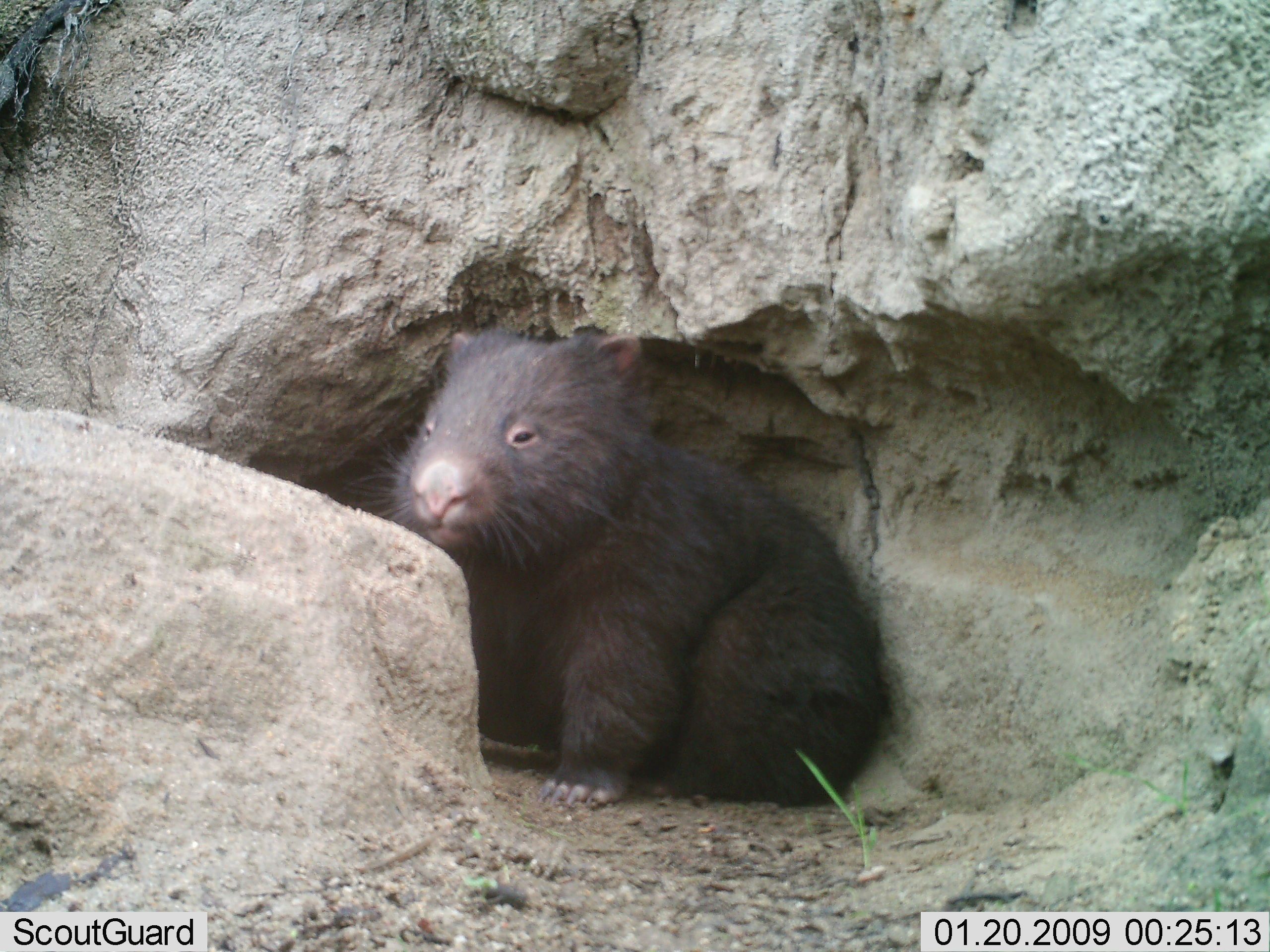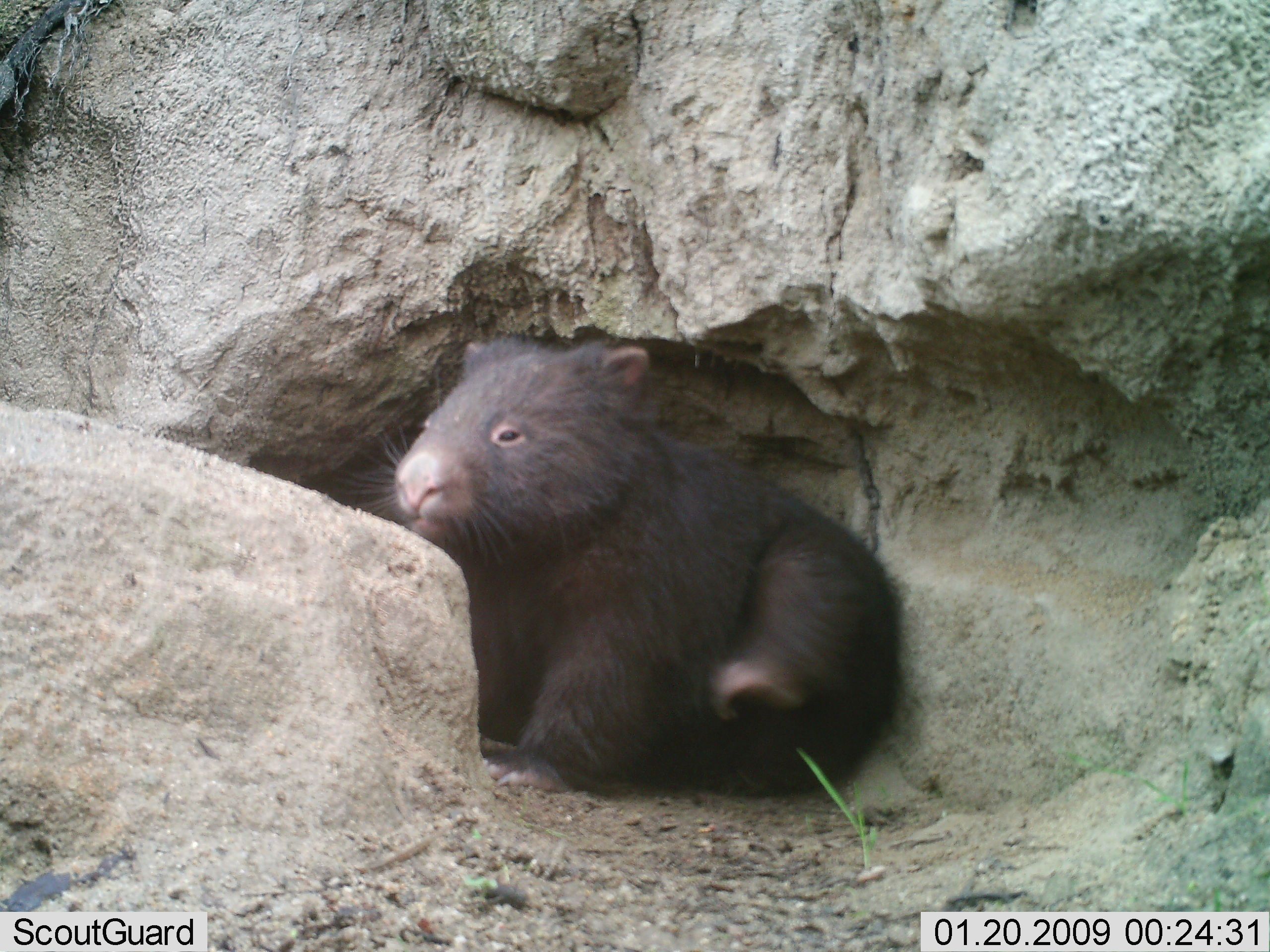Coming home from work a week or two ago, I was just a couple of kilometres from my house, on Scotts Lane. The car in front of me slowed to a stop. A medium sized mammal with a distinctly square bum ambled in front of Ted’s car and disappeared into the dark forest.
A wombat! A Common or Bare-nosed Wombat – in Porcupine Ridge! There are plenty of Wombats around Trentham, Glenlyon, and throughout the Wombat Forest, but in 15 years of living in Porcupine Ridge I had accepted the fact that while we have koalas, the wombats didn’t occur this far north. However, it seems the fortunes of wombats in western Victoria are changing!
In early 2016, a wombat was caused quite a stir as it was photographed in the Gunbower forest, literally hundreds of kilometres from the nearest population. Peter Menkhorst, from the Arthur Rylah Institute was contacted to comment and he stated “The most westerly population of wombats on the Great Dividing Range is around Trentham and Daylesford, where the Campaspe begins”. He believed the wombat may have been an orphan pouch young that was released far from where it was rescued. See here for the story.

A healthy wombat captured on camera by Connecting Country in Sutton Grange
After seeing my Porky Ridge wombat, I searched online and found a fantastic website called WomSAT. This website is an initiative of the University of Western Sydney, and encourages people Australia-wide to record their wombat sightings. The map is really is easy to use, and enables you to note down whether the wombat was dead or alive, and if it suffered from mange. You can also record burrows.
On this map, there were at least eight sightings of living wombats between Bendigo and Daylesford from 2015- 2016, in Harcourt, south of Bendigo in Sedgwick and a big concentration in the Baynton area to the east.
I had a chat with my Connecting Country work colleagues Bonnie and Jarrod who have been documenting an increase in wombat sightings all through the Harcourt and especially Sutton Grange area – one property had a network of burrows with 50-60 entrances!
So what is going on?! My Mammals of Victoria book, also by Peter Menkhorst, states that wombat distribution on a local level is ‘probably most dependent on the availability of suitable burrow sites in association with food supply’. The wombats do not like very dense forest, but any open habitat seems to do – with habitats ranging from alpine heathland, to wet forests, dry forests and coastal scrub and tea tree heath. Most of the burrows noted by Bonnie and Jarrod have been on creeklines which are tributaries of the Coliban River, and surrounded by open forest or woodland.

The same wombat having a cute little scritch 🙂
Wombats destroy fences, dig in dam walls and other mischief when going about their daily activities. These habits meant that wombats were declared vermin in 1906, and there was a bounty on them from 1925 – 1966. This put the already diminishing western Victorian populations on an even deeper downward spiral and they disappeared from the volcanic plains and indeed, anywhere north of the Great Dividing Range.
Anecdotally, the recent increase in wombat numbers has been noticed after the Redesdale fires, part of the devastating Black Saturday fires. The fires may have caused a dispersal of the wombats into previously unoccupied territory.
Although the days of wombat bounties are over, according to the Dept of Environment Land Water and Planning ( DELWP) anyone can still apply for a permit to scare, remove or kill wildlife that is deemed to be causing economic hardship. In 2016, 270 applications were made, and a maximum number of 3,975 wombats killed. They helpfully point out that the actual number killed may be less. One can only hope these new populations are regarded as harmless and benign, and even as charming and beneficial ecosystem engineers!
Cars and dogs also take their toll on wombats. Those wombats that manage to avoid these threats may find themselves afflicted by sarcoptic mange – a hideous parasite that they catch from foxes. The mites cause the most severe mange affected skin and swelling around the eyes – and the wombat gets very sick indeed, and eventually dies. Happily, wombat lovers and advocates have discovered that they can add a pesticide ointment to a flap on an affected wombat’s burrow and this treatment saves the wombat without it having to be captured and taken to a shelter.
If you are in open forest along a creekline north of Daylesford, keep an eye out, a wombat family could be your new neighbours!
Fantastic! They have been moving back into Long Forest, down south of the ranges, too.
That’s great to hear!!! I haven’t been to long forest for years – a special spot. Thanks!
Really fascinating. Thanks! Amazing how many wildlife tracking projects there are around, and lots using citizen science too. I live on the ridges of the Hawkesbury and never see wombats or wombat diggings (too rocky perhaps?).
Thank you! Look you never know – we live in rocky clay areas interspersed with red soil paddocks… but they seem to be living in the rocky slopes. Fascinating eh! and so great to share a positive story : )